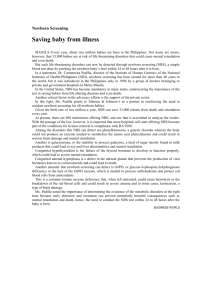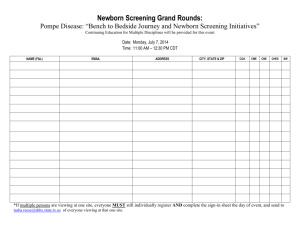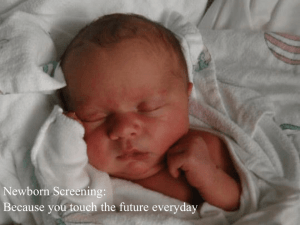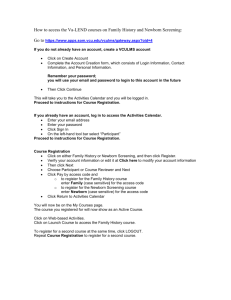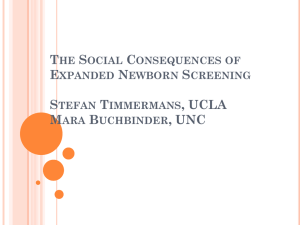Ontario's Expanded Screening Program
advertisement
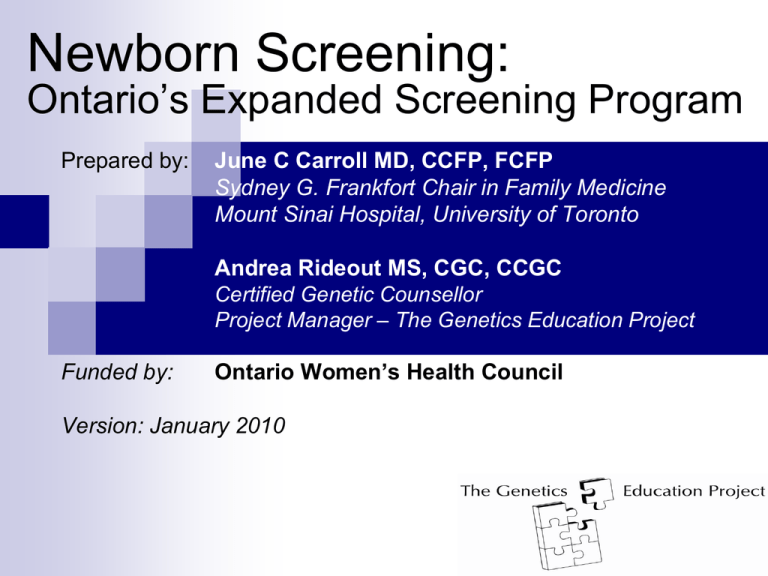
Newborn Screening: Ontario’s Expanded Screening Program Prepared by: June C Carroll MD, CCFP, FCFP Sydney G. Frankfort Chair in Family Medicine Mount Sinai Hospital, University of Toronto Andrea Rideout MS, CGC, CCGC Certified Genetic Counsellor Project Manager – The Genetics Education Project Funded by: Ontario Women’s Health Council Version: January 2010 Acknowledgments Reviewers: Members of The Genetics Education Project Ontario Newborn Screening Program: Dr. Michael Geraghty, Mireille Cloutier MSc., Christina Honeywell MSc., Sari Zelenietz MSc, Shelley Kennedy MSc. Funded by: Ontario Women’s Health Council as part of its funding to The Genetics Education Project * Health care providers must use their own clinical judgment in addition to the information presented herein. The authors assume no responsibility or liability resulting from the use of information in this presentation. Newborn Screening – What’s new? Previously: PKU, congenital hypothyroidism, hearing loss Beginning April 2006: Progressive expansion to 29 primary disorders NBS includes hearing screening but, the focus of this module will be on metabolic, endocrine and hematologic conditions Expanded NBS – 29 conditions 20 inborn errors of metabolism 3 hemoglobinopathies 2 endocrine disorders Congenital hypothyroidism Congenital adrenal hypoplasia 3 other metabolic disorders Cystic fibrosis Galactosemia Biotinidase deficiency Hearing loss Benefits of NBS Identification Early intervention Reduced morbidity & mortality Family planning Risks of NBS Parental anxiety (false positives) Missed diagnosis (false negatives) The right ‘not to know’ Unanticipated outcomes Labelling – diagnosis of benign conditions NBS: how & where is it done? Method: Heel prick Sample collection: newborn screening card Testing Location: Ontario Newborn Screening Program at Children’s Hospital of Eastern Ontario (CHEO) Transportation: NBS cards are sent via courier service Timing of Testing Acceptable samples between 1 day (24 hours) and 7 days after birth Best time for sample: between 2 days (48 hours) and 3 days (72 hours) after birth If tested before 1 day (24 hours) of age, REPEAT the test within 5 days* If the baby is >5 days, screening is still available Contact Ontario NBS program for details * Repeat sample within 5 days has been the Ontario standard of care since 2001 Special Considerations Prematurity or illness If <37 weeks - collect specimen at 5-7 days old Indicate this on NBS card May have false positive test results Total Parenteral Nutrition (TPN) Certain amino acids and organic acids will be elevated Indicate this on NBS card Transfusion Disorders may be missed Ideally complete card and obtain sample before transfusion Early discharge If prior to 24 hours, parents should be informed that a repeat sample must be done The Heel Test What makes a good spot? See Ontario NBS Program website – educational resource for blood spot collection: http://www.newbornscreen ing.on.ca NBS: For your information Location Ontario Newborn Screening Program (ONSP) at CHEO http://www.newbornscreening.on.ca Tandem Mass Spectrometry Allows screening for multiple conditions concurrently Same cost to screen for one condition as multiple Increased sensitivity and specificity Screening for some metabolites can give information about several diseases Educational materials MOH & ONSP have developed materials for the public and healthcare providers Parents will ask you about NBS NBS Report Screen Positive Results Screen positive means: Further testing is required to confirm the diagnosis Does NOT mean that the infant is affected ONSP will immediately notify regional treatment centre Regional treatment centre will notify the infant’s healthcare provider and/or parents and arrange confirmatory testing If diagnosis is confirmed, regional treatment centre will provide management counselling & follow up Report will be mailed to referring hospital, provided that correct information is completed on the screening card. Results of Expanded NBS by MS/MS Schulze et al. Pediatrics 2003 250,000 neonates screened for 23 inborn errors of metabolism 106 newborns with confirmed metabolic disorder 70 required treatment Overall prevalence of metabolic disorder = 1/2400 825 false positives (0.33% false positive rate) Overall specificity = 99.67% (PPV = 11.3%) Overall sensitivity = 100% for classic forms of disorders = 92.6% for variants 61 /106 were judged to have benefited from screening and treatment 58% of true positives 1/4100 newborns Negative Results Results will go to: Submitting health care professional/hospital If you suspect that an infant or child has symptoms of a screened condition and their NBS results are negative – please refer to the appropriate specialist for evaluation NBS panel does not screen for every metabolic condition NBS is a screening test – not diagnostic Expanded NBS – 29 conditions 20 inborn errors of metabolism 9 organic acid disorders 5 fatty acid oxidation disorders 6 amino acid disorders 3 hemoglobinopathies 2 endocrine disorders 3 other metabolic disorders Hearing loss Inborn errors of metabolism Rare Usually autosomal recessive inheritance consanguinity is more common Symptoms secondary to a problem in the metabolic pathway Usually not significant dysmorphism Early recognition and intervention can be lifesaving Frequency of Inborn Errors of Metabolism (IEM) using MS/MS Tandem Mass Spectrometry Disorders: Germany 2003 USA 2006 Amino Acid Disorders (*) 1/3,800 1/14,600 Organic Acid Disorders 1/14,700 1/15,900 Fatty Acid Oxidation 1/10,400 Disorders IEM combined frequency(*) ~1/4,300 1/10,100 ~1/2,400 All NBS: IEM, CF, CAH, ~1/1,500 Not biotinidase, galactosemia reported (*) Does not include tyrosinemia type 1 and 2 Organic Acid Disorders Isovaleric acidemia (IVA) Glutaric acidemia type 1 (GA1) Hydrodroxymethylglutaric acidemia (HMG) Multiple carboxylase deficiency (MCD) Methylmalonic acidemias (MMA) Methylmalonic acidemia (Cbl A, B) 3-methylcrotonyl glycinuria (3MCC) Propionic acidemia (PA) Β-ketothiolase deficiency (BKT) Organic Acid Disorders What are organic acid disorders? Body cannot metabolize certain amino acids and fats Accumulation of organic acids in blood and urine Serious potentially preventable effects on health and development, including death Symptoms acute encephalopathy, vomiting, metabolic acidosis, ketosis, hyperammonemia, hypoglycemia, coma dehydration, failure to thrive, hypotonia, global developmental delay sepsis, death Treatment Low protein diet / restrict amino acids, Supplements: carnitine, biotin, riboflavin, glycine Avoid fasting Fatty Acid Oxidation Disorders Medium-chain acyl-CoA dehydrogenase (MCAD) deficiency Very long-chain acyl-CoA dehydrogenase deficiency (VLCAD) Long-chain L-3-OH acyl-CoA dehydrogenase deficiency (LCHAD) Trifunctional protein deficiency (TFP) catalyzes 3 steps in mitochondrial betaoxidation of fatty acids Carnitine uptake defect (CUD) Fatty Acid Oxidation Disorders Medium-chain acyl-CoA dehydrogenase (MCAD) deficiency Very long-chain acyl-CoA dehydrogenase deficiency (VLCAD) Long-chain L-3-OH acyl-CoA dehydrogenase deficiency (LCHAD) Trifunctional protein deficiency (TFP) catalyzes 3 steps in mitochondrial betaoxidation of fatty acids Carnitine uptake defect (CUD) Disorders of Fatty Acid Oxidation What are disorders of fatty acid oxidation? Breakdown of fatty acids in mitochondria is an essential part of body’s ability to produce energy Disorder: inability to break down fatty acids Symptoms Decompensate with any catabolic stress fever, fasting, intercurrent illness Hypoketotic hypoglycemia, liver, muscle, heart disease Lethargy, seizures, coma, sudden death (SIDS) Treatment Avoid fasting IV glucose when ill to prevent hypoglycemia Frequent feeding Amino Acid Disorders Phenylketonuria (PKU) Maple syrup urine disease (MSUD) Tyrosinemia type 1 (TYR 1) Common in French Canadians Homocystinuria (HCY) Citrullinemia (CIT) Argininosuccinic aciduria (ASA) Disorders of Fatty Acid Oxidation What are disorders of fatty acid oxidation? Breakdown of fatty acids in mitochondria is an essential part of body’s ability to produce energy Disorder: inability to break down fatty acids Symptoms Decompensate with any catabolic stress fever, fasting, intercurrent illness Hypoketotic hypoglycemia, liver, muscle, heart disease Lethargy, seizures, coma, sudden death (SIDS) Treatment Avoid fasting IV glucose when ill to prevent hypoglycemia Frequent feeding Amino Acid Disorders Phenylketonuria (PKU) Maple syrup urine disease (MSUD) Tyrosinemia type 1 (TYR 1) Common in French Canadians Homocystinuria (HCY) Citrullinemia (CIT) Argininosuccinic aciduria (ASA) Amino Acid Disorders What are amino acid disorders? Occur when the body cannot either metabolize or produce certain amino acids Result in toxic accumulation of substances Serious potentially preventable effects on health and development including death Symptoms (untreated) example PKU Hyperphenylalaninemia (neurotoxic) Microcephaly, epilepsy, mental retardation, behaviour problems Treatment Diet: reduce phenylalanine, low protein, supplement cofactors or essential amino acids Expanded NBS – 29 conditions 20 inborn errors of metabolism 3 hemoglobinopathies 2 endocrine disorders Congenital hypothyroidism Congenital adrenal hyperplasia 3 other metabolic disorders Hearing loss Endocrine Disorders: CH Congenital Hypothyroidism (CH) What is CH? inadequate thyroid hormone production Anatomic defect in gland, dyshormogenesis, iodine deficiency Symptoms MR, ↓ growth & bone maturation, neurologic problems: spasticity, gait abn, dysarthria, autistic behaviour Treatment Diagnosis made before 13 days to prevent symptoms Thyroid hormone replacement Endocrine Disorders: CAH Congenital Adrenal Hyperplasia (CAH) What is CAH? Impaired synthesis of cortisol by the adrenal cortex leads to ↑↑↑ androgen biosynthesis Inability to maintain adequate energy & blood glucose level to meet stress of injury & illness Symptoms Virilization (♀ ambiguous genitalia), precocious puberty, infertility, short stature Renal salt wasting leads to FTT, vomiting, dehydration, hypotension, hyponatremia, & hyperkalemia Treatment Glucocorticoid replacement therapy Expanded NBS – 29 conditions 20 inborn errors of metabolism 3 hemoglobinopathies Sickle cell disease (Hb-SS) SC disease (Hb-SC) Sickle beta thalassemia Other hemoglobinopathies may reported if clinically significant 2 endocrine disorders 3 other metabolic disorders Hearing loss Sickle Cell Disease What is sickle cell disease? (Hb SS) Change in the shape of the betaglobin component of the hemoglobin molecule that interferes with hemoglobin’s ability to carry oxygen Symptoms Painful vaso-occlusive crises, hemolytic anemia, frequent infections, tissue ischemia, chronic organ dysfunction Diagnosis Quantitative hemoglobin electrophoresis and/or Molecular analysis Do not rely on solubility testing methods (Sickledex etc) Treatment Prophylactic penicillin (84% reduction in infection) Vaccinations (pneumococcal, influenza) Aggressive treatment of fever and dehydration Expanded NBS – 29 conditions 20 inborn errors of metabolism 3 hemoglobinopathies 2 endocrine disorders 3 other metabolic disorders Biontinidase deficiency Galactosemia Cystic fibrosis Hearing loss Other Disorders: Biotinidase deficiency What is biotinidase deficiency? Biotinidase is responsible for recycling biotin – a cofactor for 4 dependant carboxylases Symptoms Metabolic ketoacidosis, organic aciduria, mild hyperammonemia Seizures, hypotonia, ataxia, developmental delay, vision problems, hearing loss, cutaneous abnormalities Treatment 5-10mg of oral biotin per day, long term treatment prevents all symptoms Other Disorders: Galactosemia What is galactosemia? Lactose is main sugar in breast milk & infant formulas Metabolized into glucose and galactose in the intestine Unable to break down galactose Symptoms Feeding problems, FTT, bleeding, infection, liver failure, cataracts, mental retardation, death Treatment Lactose-galactose-restricted diet must be started in first 10 days of life to prevent symptoms Even with treatment - ↑ developmental delay, speech problems, abn motor function, premature ovarian failure Other Disorders: Cystic fibrosis What is cystic fibrosis? Due to mutations in the CFTR gene which is responsible for chloride regulation and other transport pathways. Symptoms Chronic sinopulmonary disease Gastrointestinal/nutritional abnormalities Azoospermia (males) Salt loss syndrome Shortened life span – but improving with treatment Treatment Pulmonary: oral, inhaled, or IV antibiotics, bronchodilators, antiinflammatory agents, mucolytic agents, chest physiotherapy Gastrointestinal: Nutritional therapy special formulas for weight gain via improved intestinal absorption, and additional fat-soluble vitamins & zinc to prevent deficiencies Cases Case 1 Carmen and George bring Amy into your office for 1 week visit Healthy 1 week old Parents worried re risk of SIDS First daughter died of SIDS 5 years earlier Carmen’s cousin died of SIDS at 18 months Case 1: Amy – 5 days old You receive a call that Amy has screened positive for MCAD deficiency Medium chain acyl-CoA dehydrogenase deficiency You ask Carmen and George to bring her in that day Healthy 5 day old Parents worried about risk of SIDS First daughter died of SIDS 5 years earlier Carmen’s cousin died of SIDS months Case 1 Legend Prostate cancer SIDS British / French Irish / German 79 Prost Ca Dx 74 MI died 6569 A&W 39 A&W 37 Schizophrenic 35 George A&W 32 Carmen A&W P S 7 A&W 5 A&W 29 A&W 11 wk SIDS Amy A& W 72 A&W 25 A&W S 49 Accident SIDS 13 months Case 1 Amy’s expanded newborn screening report is the following: Screen positive for medium chain acyl-CoA deficiency MCAD (medium chain acyl-CoA deficiency) Incidence 1 in 4,900 – 1 in 17,000 most prevalent in North Europeans Inheritance Autosomal recessive (Gene: ACADM) Enzyme Medium-chain acyl-coenzyme A dehydrogenase Function Mitochrondrial fatty acid β-oxidation Required for energy and ketone body production Important during prolonged fasting MCAD: Symptoms Usually presents at 3 to 24 months Triggered by fever, illness, or fasting Symptoms: Hypoglycemia, vomiting Lethargy → coma → death Encephalopathy, respiratory arrest, hepatomegaly, seizures Long term outcomes after a clinical episode: developmental & behavioural disabilities, chronic muscle weakness, seizures, cerebral palsy, ADD MCAD: a preventable cause of SIDS Sudden death is the first symptom in 25% of MCAD cases Early diagnosis and treatment of MCAD can prevent sudden death MCAD responsible for ~1% of SIDS cases, all FAO disorders ~4% Opdal et al. Pediatrics 2004;114:506-512 MCAD: Management Infants require frequent feedings Formulas containing medium chain triglycerides as the primary source of fat should be avoided Avoid prolonged fasting, hypoglycemia Aggressive treatment of illness often with IV fluids especially when vomiting Case 2 Angela receives a call from the Ontario Newborn Screening Program for a repeat NBS sample for her newborn, Liam. Angela comes to your office for a routine newborn visit. Liam’s newborn screening report: Positive, for cystic fibrosis Category B IRT>96% DeltaF508 (one mutation identified) What are the next steps? ~1 in 40 chance of being affected with CF Sweat chloride test is next step 3 possible results: Abnormal – affected with CF Borderline – inconclusive, follow up with specialist Normal – unaffected, but carrier of CF Blood work: Confirmatory genetic testing Genetic counselling is recommended NBS for cystic fibrosis Some evidence that early identification leads to better outcomes Lower incidence of malnutrition Improved growth (height, weight) Better lung function parameters at 10 years of age no evidence of difference in adulthood ?improved survival by 10 years of age ?reduced mortality Identification enables family planning Liam’s results Sweat test results – Normal Liam is a carrier of CF He will not develop CF Parents Angela and James have genetic counselling… Angela – carrier of CF deltaF508 mutation + normal gene James – carrier of CF R553X mutation + normal gene Risk to have a child affected with CF 25% with each pregnancy NBS – Bottom Line Offer newborn screening Discuss the benefits Discuss how testing is done Discuss timing Repeat sample sometimes required Discuss difference between screening and diagnostic test Discuss possible results Answer questions/brochure Provincial Educational Materials www.health.gov.on.ca/newbornscreening MOHLTC INFOline at 1-866-532-3161/TTY: 1800-387-5559 Contact the Ontario Newborn Screening Program: Telephone: 613-738-3222 www.newbornscreening.on.ca Educational materials are available free-of-charge and can be ordered through www.health.gov.on.ca or by calling 1-877-844-1944 Education: http://www.health.gov.on.ca Disorder Fact Sheets www.health.gov.on.ca/ne wbornscreening Parent Fact Sheets www.newbornscreening. on.ca Resources ONSP Newborn Screening Website: http://www.newbornscreening.on.ca/bins/index.asp March of Dimes: www.marchofdimes.com Genetests: www.genetests.org National Newborn Screening & Genetics Resource Center: genes-r-us.uthscsa.edu Pediatrix – US private lab offering NBS www.pediatrix.com Resources American College of Medical Genetics – fact sheets http://www.acmg.net/resources/policies/NBS/NBSsections.htm American Academy of Pediatrics – fact sheets http://aappolicy.aappublications.org/cgi/content/abstra ct/pediatrics;118/3/e934 American Academy of Family Physicians – Information & resources http://www.aafp.org/afp/2008/0401/p987.html Ontario Medical Association – Important changes to NBS in Ontario http://www.oma.org/Health/newborn/06newborn.asp The Genetics Education Project Committee June C Carroll MD CCFP Judith Allanson MD FRCP FRCP(C) FCCMG FABMG Sean Blaine MD CCFP Mary Jane Esplen PhD RN Sandra Farrell MD FRCPC FCCMG Judy Fiddes Gail Graham MD FRCPC FCCMG Jennifer MacKenzie MD FRCPC FAAP FCCMG Wendy Meschino MD FRCPC FCCMG Fiona Miller PhD Joanne Miyazaki Andrea L. Rideout MS CGC CCGC Linda Spooner RN BScN Cheryl Shuman MS CGC Anne Summers MD FCCMG FRCPC Sherry Taylor PhD FCCMG Brenda Wilson BSc MB ChB MSc MRCP(UK) FFPH References 1. 2. 3. 4. Ontario Ministry of Health and Long Term Care, News release November 2, 2005: Ontario becomes national leader in newborn screening, New state-of-the-art testing program means that children will have a better start on life http://www.health.gov.on.ca/english/media/news_releases/archive s/nr_05/nr_110205.html Ontario Ministry of Health and Long Term Care, News release November 23, 2006: McGuinty government expands newborn screening, Screening for cystic fibrosis brings total number of tests to 28. http://www.health.gov.on.ca/english/media/news_releases/archive s/nr_06/nov/nr_112306.html Bellis MA, Hughes K, Hughes S, Aston JR. Measuring parent discrepancy and its public health consequences. J Epidemiol Community Health 2005; 59: 749-754. Ontario Ministry of Health and Long Term Care, Newborn Screening website: http://www.health.gov.on.ca/english/providers/program/child/scree ning/screen_sum.html www.health.gov.on.ca/english/providers/program/child/screening/ screen_sum.html References 5. 6. 7. 8. NCCLS (National Committee for Clinical Laboratory Standards now known as CLSI – Clinical Laboratory Standards Institute) LAR-A3 “Blood collection on filter paper for neonatal screening programs: approved standard, third edition.” “Simple Spot Check” 04/03/02 Lit. #718 produced by Schleicher & Schuell BioScience Inc. 10 Optical Ave, Keene NH 03431 USA. Scheicher & Schuell BioScience GmbH P.O. Box 1160, D-37582 Dassel, Germany. Waston MS, Mann MY, Lloyd-Puryear MA, Rinaldo P, Howell RR. Executive summary: Newborn screening panel and system. Genet Med 2006; 8 (5, supplement): 1s-11s. Schulze A, Lindner M, Kohlmuller D, Olgemoller K, Mayatepek E, Hoffmann GF. Expanded newborn screening for inborn errors of metabolism by electrospray ionization-tandem mass spectrometry: Results, outcome and implications. Pediatrics 2003; 111:1399-1406. References 9. Applegarth Da, Toone JR, Lowry RB. Incidence of inborn errors of metabolism in British Columbia, 1969 – 1996. Pediatrics 2000: 105:e10-e16. 10. Frazier DM, Millington DS, McCandless SE, Keoberl DD, Weavil Sd, Chaing SH, Muenzer J. The tandem mass spectrometry newborn screening experience in North Carolina: 1997-2005. J Inhert Metab Dis 2006; 29:76-85. 11. Marsden D, Larson C, Levy Hl. Newborn screening for metabolic disorders. J Pediatr 2006; 148:577-584. 12. Centers for Disease Control and Prevention. Impact of expanded newborn screening – United States 2006 Morbidity and Mortality Weekly Report. 2008;57:10121015. References 13. 14. 15. 16. 17. 18. Seashore MA. Genetest Reviews: The organic acidemias: An overview. Last updated 03 July 2007. www.genetests.org. Ogier de Baulny HO, Saudubray JM. Branched-chain organic acidurias. Semin Neonatol. 2002; 7:65-74. Venditti CP. Genetests Reviews: Methylmalonic Acidemia. Last updated 18 January 2007. www.genetests.org. Korman SH. Inborn errors of isoleucine degradation: A review. Mol Genet Metab. 1006: 89:289-299. Gibson KM, Breuer J, Kiaser K, Nylan WL, McCoy EE, Ferreira P, Greene CL, Blitzer MG, Shapira E, Reverte F, Conde C, Bagnell P, Cole DEC. 3-hydroy-3-methylglutaryl-coenzyme A lyase deficiency: Report of five new patients. J Inhert Metab Dis 1988; 11:76-87. Roth KS. Holocarboxylase Deficiency. Last updated 31 August 2007. http://www.emedicine.com/ped/topic1020.htm References 19. 20. 21. 22. 23. 24. Angelini C, Federico A, Reichmann H, Lombes, Chinnery P, Turnbull D. Task force guidelines handbook: EFNS guidelines on diagnosis and management of fatty acid mitochondrial disorders. Eur J Neurol. 2006; 13:923-929. Saudubray JM, Martin D, deLonlay P, Touati G, Poggi-Travert F, bonnet D, Jouvet P, Boutron M, Slama A, Vianey-saban C, Bonnefont JP, Rabier, Kamoun P, Brivet M. Recognition and management of fatty acid oxidation defects: A series of 107 patients. J Inherit Metabo Dis. 1999; 22:488-502. Hellekson KL; National Institutes of Health. Am Fam Physician. 2001 63:1430 1432. National Institutes of Health Consensus Development Panel. National institutes of Health consensus development conference statement: Phenylketonuria screening and management, October 16-18 2000. Pediatrics 2001; 108: 972-982. Mitchell JJ, Scriver CR. Genetests Reviews: Phenylalanine hydroxylase deficiency. Last updated 29 march 2007. www.genetests.org. Morton DH, Strauss KA, Robinson DL, Puffenberger EG, Kelley RI. Diagnosis and treatment of maple syrup urine disease: A study of 36 patients. Pediatrics 2002; 109:999-1008. References 25. 26. 27. 28. 29. 30. Le Roux C, Murphy E, Liblurn M. The longest surviving patient with classical maple syrup urine disease. J Inherit Metab Dis 2006; 29:190-194. Strauss KA, Puffenberger EG, Morton DH. Genetests Reviews: Maple Syrup Urine Disease. Last updated 30 January 2006. www.genetests.org. Scott CR. The genetic tyrosinemias. Am J Med Genet Part C Semin Med Genet 2006; 142C:121-126. Russo PA, Mitchell GA, Tanguay RM. Tyrosinemia: a review. Pediatr Dev Pathol. 2001; 4:212-221. Sniderman King L, Trahms C Scott R. Genetests Reviews: Tyrosinemia Type I. Last updated 31 October 2008. www.genetests.org. Walter JH, Wraith JE, White FJ, Bridge C, Till J. Strategies for the treatment of cystathionine β-synthase deficiency: the experience of the Wilink Biochemical Genetics Unit over the past 30 years. Eur J Pediatr. 1998; 157(Suppl 2):s71-s76. References 31. 32. 33. 34. 35. 36. De Franchis R, Sperendeo MP, Sebastio G, Andria G. The Italian Study group on Homocystinuria. Clinical aspects of the cynstathionine β-synthase deficiency: how wide is the clinical spectrum? Eur J Pediatr. 1998; 157(Suppl 2):s67-s70. Picker JD. Levy HL. Genetests Reviews: Homocystinuria Caused by Cystathionine Beta-Synthase Deficiency. Last updated 29 March 2006. www.genetests.org. Summar M, Tuchman M. Proceeding of a consensus conference for the management of patients with urea acid cycle disorders. J Pediatr. 2001; 138(Suppl1):s6-s10. The Urea Cycle Disorders Conference Group. Consensus statement from a conference for the management of patients with urea cycle disorders. J Pediatr. 2001; 138(Suppl1):s1-s5. Summar, ML. Genetests Reviews: Urea Cycle Disorders Overview. Last updated 11 August 2005. www.genetests.org. Thoene, JG. Genetests Reviews: Citrullinemia Type I. Last updated 02 June 2009. www.genetests.org References 37. 38. 39. 40. Roth KS. Argininosuccinate Lyase Deficiency. Last Updated 24 March 2009. www.emedicine.com - free registration is required. If you are already registered the direct link is: http://emedicine.medscape.com/article/950752-overview American Academy of Pediatrics; Rose SR; Section on Endocrinology and Committee on Genetics, American Thyroid Association; Brown RS; Public Health Committee, Lawson Wilkins Pediatric Endocrine Society; Foley T, Kaplowitz PB, Kaye CI, Sundararajan S, Varma SK. Update of newborn screening and therapy for congenital hypothyroidism. Pediatrics. 2006 Jun;117:2290-2303. Postellon D, Bourgeois MJ, Varma S. eMedicine: Congenital Hypothyroidism. Last Updated: 23 August 2006 http://www.emedicine.com/ped/topic501.htm Merke DP, Bornstein SR. Congenital adrenal hyperplasia. Lancet. 2005; 365: 2125-2136. References 41. 42. 43. 44. 45. 46. New MI, Nimkarn S. GeneTests Reviews: Congenital Adrenal Hyperplasia, last update 7 September 2006. http://www.genetests.org. Wethers DL. Sickle cell disease in childhood: Part II. Diagnosis and treatment of major complications and recent advances in treatment. Am Fam Physician. 2000; 62: 1309-1314. Bender MA. GeneTests Reviews: Sickle cell Disease, last update 7 March 2006. http://www.genetests.org Wolf B. Worldwide survey of neonatal screening for biotinidase deficiency. J Inherit Metab Dis. 1991; 14:923-927. Wolf B. GeneTests Reviews: Biotinidase Deficiency, last update 25 September 2008. http://www.genetests.org. Bosch AM. Classical galatosemia revisited. J Inherit. Metab. Dis. 2006; 29:516-529. References 47. 48. 49. 50. 51. Schweitzer-Krantz S. Early diagnosis of inherited metabolic disorders improving outcome: the controversial issue of galactosemia. Eur J Pediatr. 2003; 162:s50-s503. Elsas LJ. GeneTests Reviews: Galactosemia, last update 27 September 2007. http://www.genetests.org Moskowitz SM, Gibson RL, Sternen DL, Cutting GR. Genetests Reviews: CFTR-Related Disorders. Last updated 19 February 2008. www.genetests.org. Yankaskas JR, Marshall BC, Sufian B, Simon RH, Rodman D. Cystic fibrosis adult care: Consensus conference report. Chest 2004;125:s1-s39. Saiman L, Siegel J. Infection control recommendations for patients with cystic fibrosis: Microbiology, important pathogens and infection control to prevent patient to patient transmission, Cystic fibrosis consensus conference on infection control participants. Am J Infection Control 2003; 31:s1-s62. References 52. 53. 54. 55. 56. 57. Cystic Fibrosis Trust Clinical Standards and Accreditation Group. Standards of care for children and adults with cystic fibrosis in the UK. May 2001. Matern D, Rinaldo P. GeneTests Reviews: Medium-Chain AcylCoenzyme A Dehydrogenase Deficiency. Last update 3 February 2005. http://www.genetests.org Opdal SH, Rognum TO. The sudden infant death gene: does it exist? Pediatrics 2004; 114:506-512. Grosse SD, Rosenfeld M, Devine OJ, Lai HJ, Farrell PM. Potential impact of newborn screening for cystic fibrosis on child survival: A systematic review and analysis. J Pediatr 2006;149:362-366. Dankert-Roelse JE, Me´relle ME.Review of outcomes neonatal screening for cystic fibrosis verses non-screening in Europe. J Pediatr 2005; 147:s15-20. Southern KW, Mérelle MME, Dankert-Roelse JE, Nagelkerke A. Newborn screening for cystic fibrosis (Review). Cochrane Database of Systematic Reviews, Issue 1, 2009.

